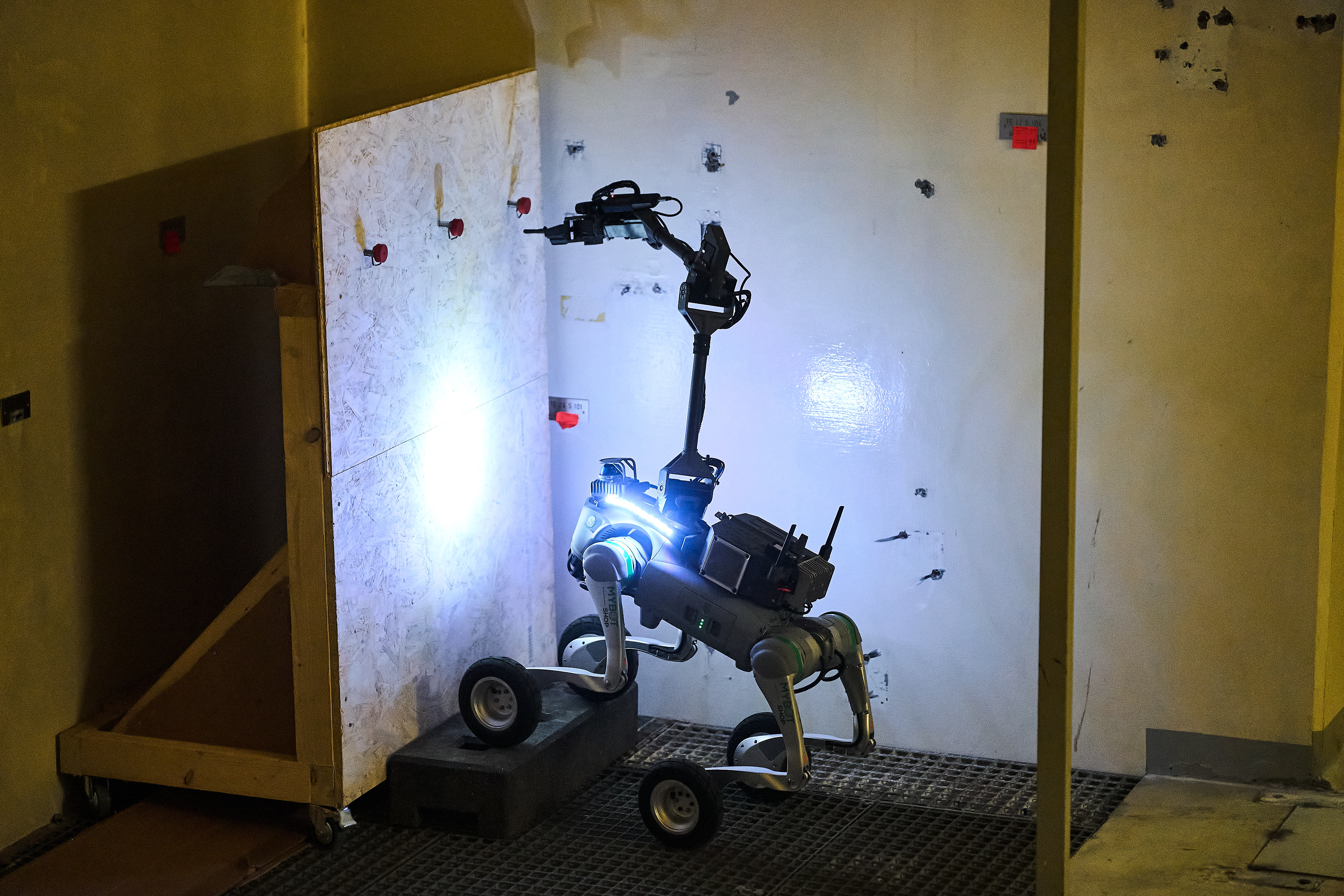Robots and drones put to the test at the European Robotics Hackathon 2025
These were probably the most difficult scenarios since the European Robotics Hackathon (EnRicH) premiered in 2017: At the beginning of July, more than 120 robotics experts from all over Europe and Canada gathered at the never-operational Zwentendorf nuclear power plant near Vienna to test their ground robots and drones under realistic conditions at the 5th EnRicH. In the three main categories “Search & Rescue,” “Mapping,” and “Manipulation,” the organizing team from the Fraunhofer Institute for Communication, Information Processing and Ergonomics FKIE had placed an emphasis on combined scenarios for driving and flying systems, which posed problems for many teams. Many – but not all.



Nomad stands in the middle of the long, bare corridor. The robot's lights are on, but nothing else has happened for quite some time. Patryk Dudziński and his colleagues from the Polish team KoNaR look somewhat perplexed at their monitors, consult with each other, try again, but Nomad does not move an inch forward. “We can ping the robot and we get a response,” explains Dudziński. “But when we want it to do more, it stops working. The problem is communication: we just can't get a stable radio connection here.”
Military provides real radioactive sources
Team KoNaR is far from alone in facing this problem at the four-day hackathon. A total of 15 teams, including school pupils and students as well as representatives from research and industry, have travelled to this unique venue to put their unmanned ground vehicles (UGVs) and unmanned aerial vehicles (UAVs) through their paces under the most difficult conditions. Tight corners, narrow spaces, steep stairs, barely any light, and metre-thick concrete and steel walls that block all radio communication with the outside world are all part of the challenge.
The biennial hackathon is hosted by the Austrian Armaments and Defence Technology Agency (ARWT), which is responsible for another unique feature: the Austrian military provides real radioactive sources that must be detected and mapped. There are exactly five sources this year, but the teams do not know this during their 30-minute runs.
Around 40 cameras monitor every corner of the hackathon area – every corridor, every bend, the well-hidden radiation sources, the machine hall more than 50 metres high that the drones are to explore, and the two heavy steel doors behind which the dummy mannequins for the “Search & Rescue” category are stored.
The team of judges consists of renowned radiation and robotics experts
EnRicH organiser Dr Frank E. Schneider, deputy head of the FKIE department “Cognitive Mobile Systems” (CMS), and his organising team closely monitor every run via these cameras. “The requirement for cooperation between flying and driving systems and an unknown, very large deployment scenario spread over two levels is a highly demanding task,” admits Schneider. “There is a lot of talk about cooperation between UAVs and UGVs, but we see that there is still considerable room for improvement here.”
With Dr. Michael Gustmann from the Kerntechnische Hilfsdienst GmbH (KHG), Jan-Peter Paulick, Technical Director at the Bundeswehr Technical Center for Land-Based Vehicle Systems, Engineer and General Field Equipment (WTD 41) , the two robotics engineers Professor Daniel Watzenig and Kenneth Pink, and Thilo Behrendt, Research Officer for Key Technologies at the Cyberagentur, the EnRicH jury team consists of renowned radiation and robotics experts. During each run, they look over the participants' shoulders and record their results. “The value of such hackathons also lies in the fact that the event creates a learning curve for the teams,” explains Behrendt. “An approach that works well in a familiar environment may not necessarily work in an unfamiliar, difficult terrain such as this.” In such cases, a Plan B is needed, which the teams develop directly on site.
Programming late into the night
Sometimes they worked late into the night. “There's no such thing as free time or finishing time at an event like this,” says Noah Heckel. The 17-year-old high school student and his two teammates from CJT-Robotics near Nuremberg have already successfully participated in several RoboCups, but at EnRicH their robot “Error 404” isn't working properly at first. “Establishing a stable connection to the network was much more difficult than we thought,” he explains. But after several night sessions, they finally solved the problem and impressed the judges with a compelling performance. “The team worked very imaginatively, creatively, and solution-oriented,” Behrendt praises. “That was a great achievement.” The team was also awarded the EnRicH “Young Scientist Award.”
Behrendt said that they saw many exciting solutions among the participants, some of which were close to what is currently being used. For example, the Polish team Husarion was the only one to use fiber optic cables as a communication solution, which enabled them to maintain the data flow to their robot “Lynx” even in the furthest corners of the nuclear power plant.
Continuation at EnRicH 2027
“A very clever approach,” agreed EnRicH organiser Schneider, who also praised the achievements in creating 3D environment models across several floors. “We saw many interesting innovations, even though all teams were hampered in their development by the necessary switch from the ROS 1 to ROS 2 robot operating system,” he concluded. Schneider already has some initial ideas for the European Robotics Hackathon 2027: “We will continue to develop and build on the proven components from this year but also have some completely new ideas,” he promises.
Further information & images:
https://enrich.european-robotics.eu
Contact
Dr Frank E. Schneider, Cognitive Mobile Systems Department
Fraunhofer Institute for Communication, Information Processing and Ergonomics FKIE
frank.schneider@fkie.fraunhofer.de I Phone: +49 228 9435481
